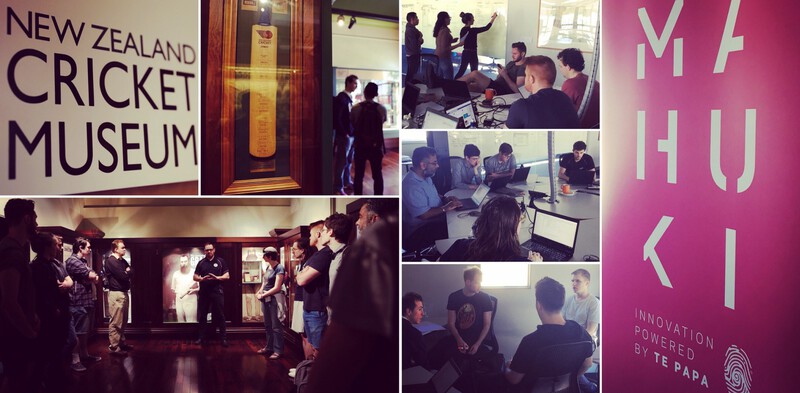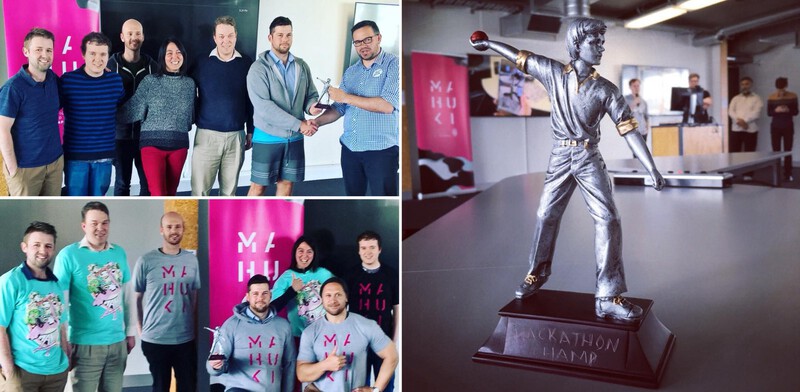Software hackathon hits NZ Cricket Museum’s challenges for six
Software Development Masters students from the Wellington ICT Graduate School are on the way to solving the NZ Cricket Museum’s challenges after a two-day hackathon.

Master of Software Development students visit the NZ Cricket Museum with Museum Director, Jamie Bell (below left), and work in teams to develop new tech ideas and solutions for the Museum.
If two heads are better than one when solving tricky problems, then 30 heads must surely be even better.
Over Thursday and Friday [November 9–10] the 30 Master of Software Development students, completing a one-year conversion Masters from the Wellington ICT Graduate School, teamed up to solve challenges put forward by the Wellington-based New Zealand Cricket Museum.
The two-day hackathon — essentially a brainstorming session to come up with new technology ideas and solutions — builds on the students’ learnings from their day-to-day studies.
“Hackathons allow students to use what they have just learned to solve real problems in innovative ways. They are given problems and then see how they can solve them using the skills and technologies they have learned”, says Dr Karsten Lundqvist, a Senior Lecturer at Victoria University.
During this hackathon students considered two main issues. Firstly, how to make static displays more dynamic by better linking the items back to the action that made them worth collecting, and also how to streamline the software museums use to manage their collections.

How do we make static displays more dynamic? Masters students check out objects on display at the NZ Cricket Museum.
“These problems are common to all museums, not just us and not just small museums,” says the NZ Cricket Museum Director, Jamie Bell.
“Museums are about providing context and connection. With our collection being focused on something as dynamic as cricket, we want to find ways to improve the connection between an object that sits in a static museum display and the on-field action that made it worth collecting.
“For example, we have many cricket bats that were used in significant matches — like the one Grant Elliott used to hit New Zealand to a Cricket World Cup final. How do we recreate the hair-on-the-back-of-the-neck feeling from when that bat was used in that moment?”
Jamie also sought the developers’ help for when the items get collected and logged in the museum’s database.
“Most museums use one of three or four collection management systems, but they all have the same issue — they’re too complicated, especially for volunteers or novice students. With about 150 fields available in the software, where most museums will only use a small proportion of these, the breadth of information requested can be daunting.”
Photographs are also important, particularly in an increasingly digital world, Jamie says.
“We need to photograph our items to detail their condition and to make them available for researchers. We’re also increasingly moving our museum experience online so we want to make more of our items publicly accessible via our website.
“But there are currently too many steps between taking a photograph and uploading it. It’s time-consuming and clunky, so I asked the students to find a solution.
“I really like working with students, giving them an opportunity to develop their skills. I like their ability to think laterally,” Jamie says.
Mahuki, Te Papa’s innovation accelerator hub, sponsored the hackathon, which is a part of the students’ study programme. As well as nutritionally fuelling the students — a vital element in a hackathon — Mahuki’s representatives helped assess the viability of the teams’ concepts alongside Jamie Bell at the end of the second day.
After two days of working in teams, devising and designing ideas, the winners were announced.
The winners were team Crickmo, who developed a geo-location app to create an interactive mobile treasure hunt for fans at Wellington’s Basin Reserve.

The winning team, Crickmo, accept their trophy from NZ Cricket Museum Director, Jamie Bell (above left) and pictured with Mahuki’s Outreach Coordinator, Sulu Fiti (below left). The Hackathon Champ trophy stands in full glory (right) while students present their final concepts to the judges.
Acting Director of the Wellington ICT Graduate School Susan Andersen congratulated the students on their hard work.
“This is a great opportunity for our students to build a Proof of Concept that can then grow into a start-up idea.
“This is where Mahuki can get involved, as afterwards the students can take what they have and apply to be part of the next Mahuki incubator programme, beginning in August 2018.”
NZ Cricket Museum Director Jamie Bell says he was impressed with the concepts and solutions the students put forward.
“All of the teams came up with unique solutions to the problems put to them. Some focused on a core element and developed a simple solution, others created an engaging experience related to the Museum, and some thought laterally to how a concept could fit our brief but develop into a product in its own right.
“It’s been great for the Museum to be part of this hackathon, following on from our burgeoning relationship with Mahuki and some of the teams there. The creativity and skillset these students have shown offers an exciting future for museums, heritage, and storytelling.”
nzcricketmuseum.co.nz
Our 12-month Master of Software Development (MSwDev) is open to anyone with a Bachelor’s degree. This conversion programme has been designed for people from non-information technology disciplines who want to become software developers.
Next intake for MSwDev is July 2018 — June 2019.
Applications for 2018 are open now. Book an advice session to find out more about the programmes we offer.



